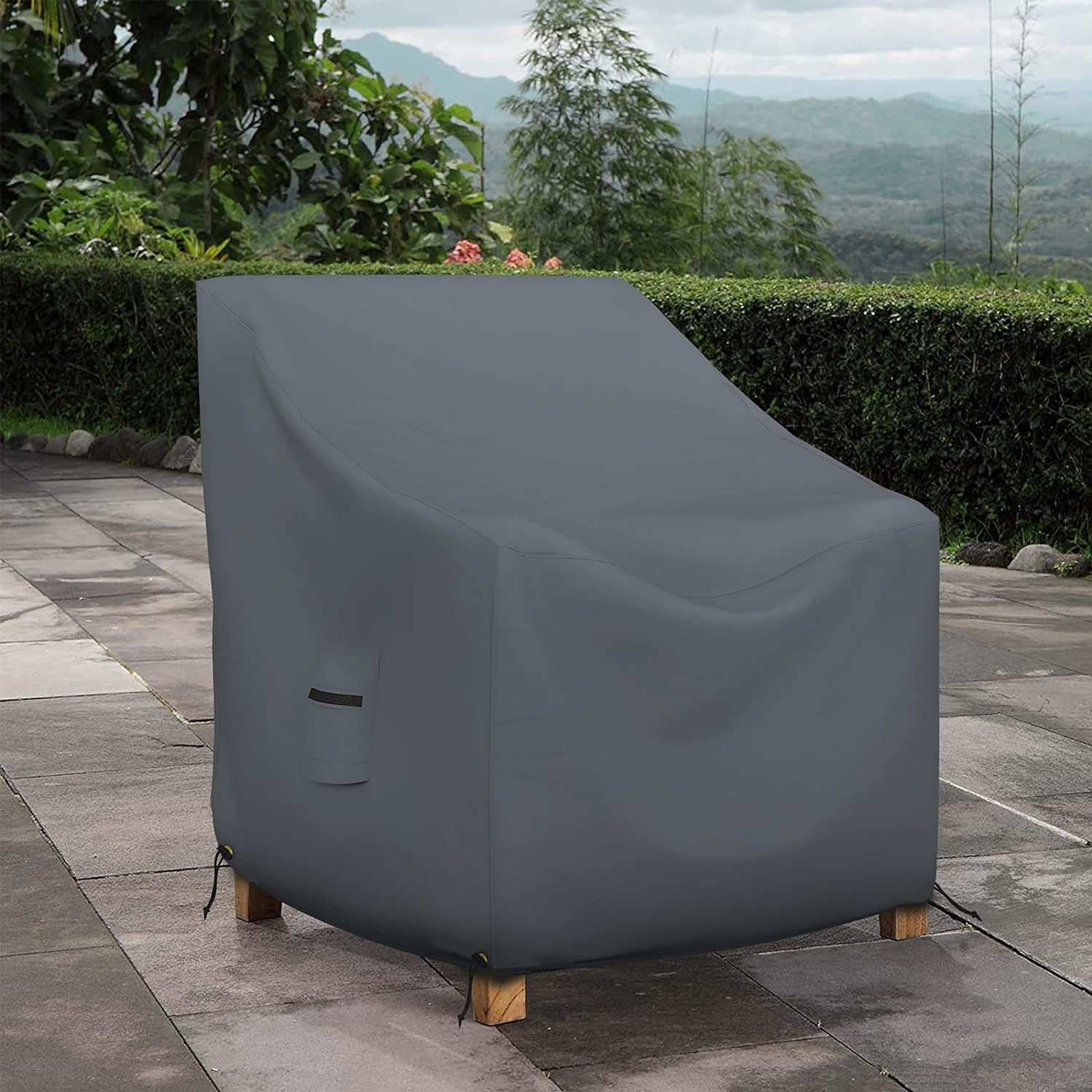Just like there are many different types and styles of patio furniture on sale in the UK, there are a variety of different patio surface materials.
And just like there are pros and cons to different furniture materials, there are numerous advantages and disadvantages to different types of patios too.
The decision-making process when choosing new is also much the same and it will depend on factors like budget, the surrounding landscape, the intended use of the patio, and personal preference.
In this article, we want to look at the suitability of different surface materials to help you identify if metal, wood, rattan or resin/plastic patio furniture will work best in your outdoor area.
What types of patio furniture go best on different types of patio surfaces?
From natural stone to timber decking, there are a host of materials to choose from and knowing what to pair with which outdoor patio furniture material can be tricky.
Pairing the wrong materials could even cause damage, additional costs or extra maintenance, so we want to take a closer look at the different surface materials and assess their suitability for different types of outdoor patio furniture.
We must also stress that there is no right and wrong, and for any of the issues we identify, we will also offer solutions and precautions to make sure both the furniture and surface remain protected and in good condition.
Let us start by taking a closer look at the popular patio materials in the UK, and then we will share some of our tips for protecting them and your furniture:
1. Natural Stone Paving
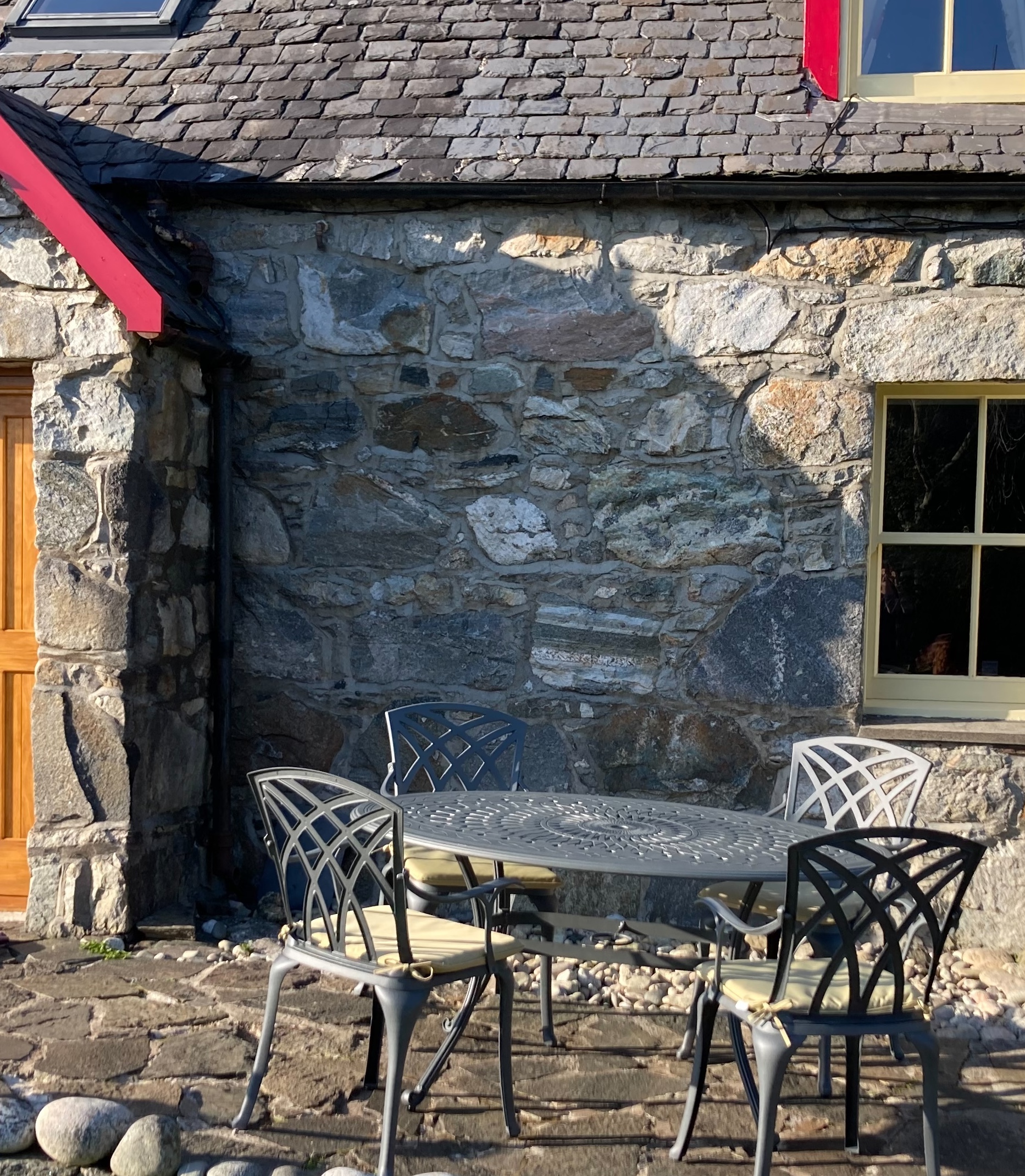
Natural stones, such as sandstone, limestone, slate, and granite, are probably the most popular choice for patios in the UK, and they offer a timeless, elegant look, in materials that can withstand our inclement weather.
Sandstone, in particular, is a very common material due to its range of colours, durability and affordability. It often has more ridges in it which makes it slightly more slip-resistant than limestone and granite, but all 3 are a patio-worthy choice.
The downside of natural stone is that heavy outdoor patio furniture could cause wear and tear over time. So be mindful of the weight of the furniture you choose, especially if you have a softer type of natural stone like limestone or sandstone.
Natural stone can also be sensitive to specific chemical cleaning solutions, so always use an appropriate stone-safe cleaner when cleaning the patio and furniture. Regular maintenance and sealing the stone with a specialist sealant will help to prolong its life and protect it from weathering and stains.
Overall, while natural stone is a suitable surface for patio furniture, it's essential to take care of how you arrange and maintain your outdoor space to ensure both the furniture and the stone surface remain in good condition. We looked at this in more detail in our Can you put metal garden furniture on a stone patio? article.
Pros: Natural, aesthetically pleasing, highly durable, long-lasting, available in various types, will increase property value.
Cons: Generally more expensive than concrete pavers, irregular surfaces can make it less suitable for some furniture arrangements, some types of stone may require occasional sealing to maintain their appearance.
Best With: Wood, Rattan, Resin, Composite and Cast Aluminium Furniture.
2. Concrete Paving
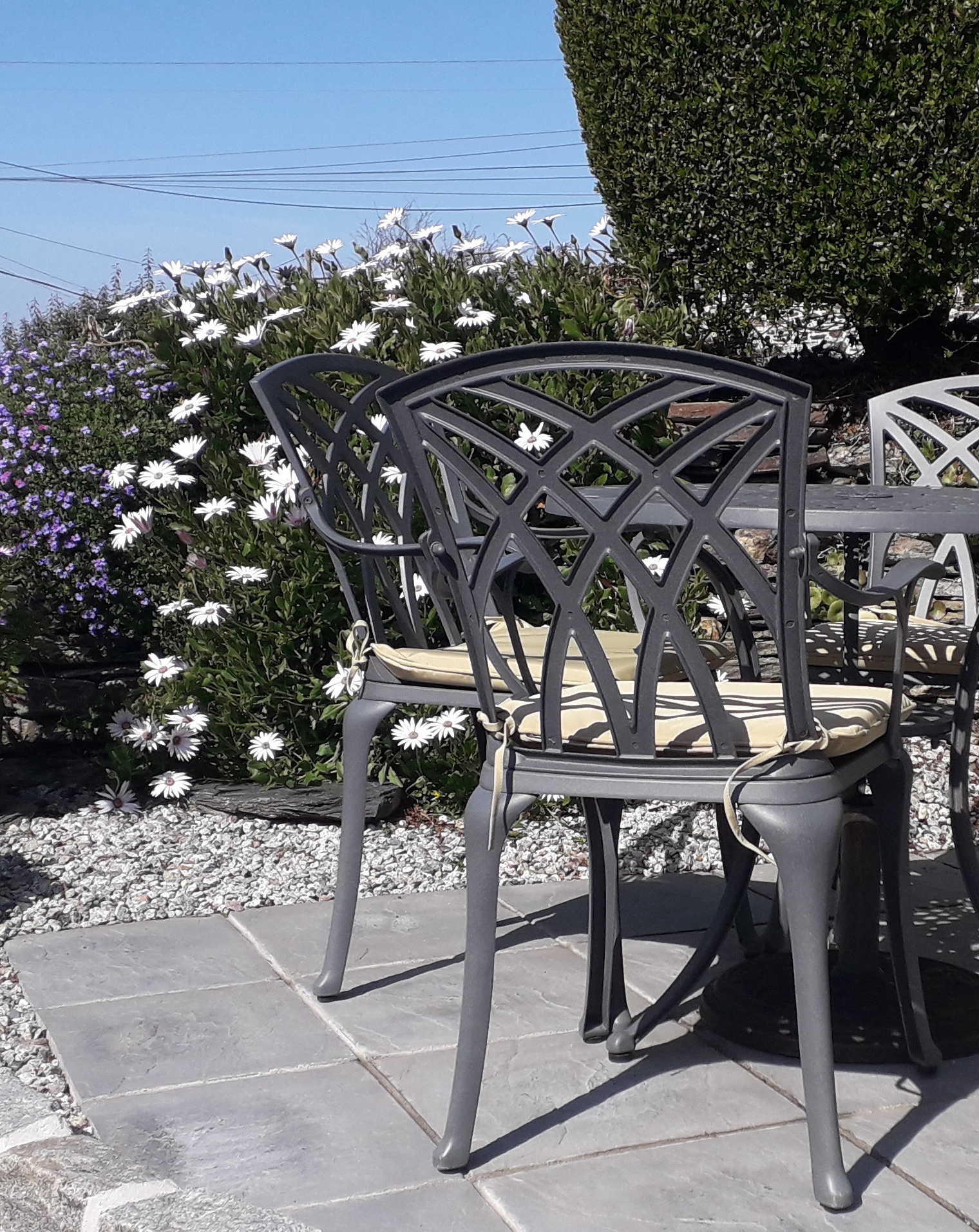
Concrete slabs or pavers are another popular patio type as they are cost-effective and versatile. Available in a wide range of sizes, shapes, and finishes, they allow you to create a host of design solutions.
Many concrete pavers will replicate the appearance of natural stone or wood (as shown in the photo below), so you can create the look without the frequency of maintenance, although they’re not maintenance-free.
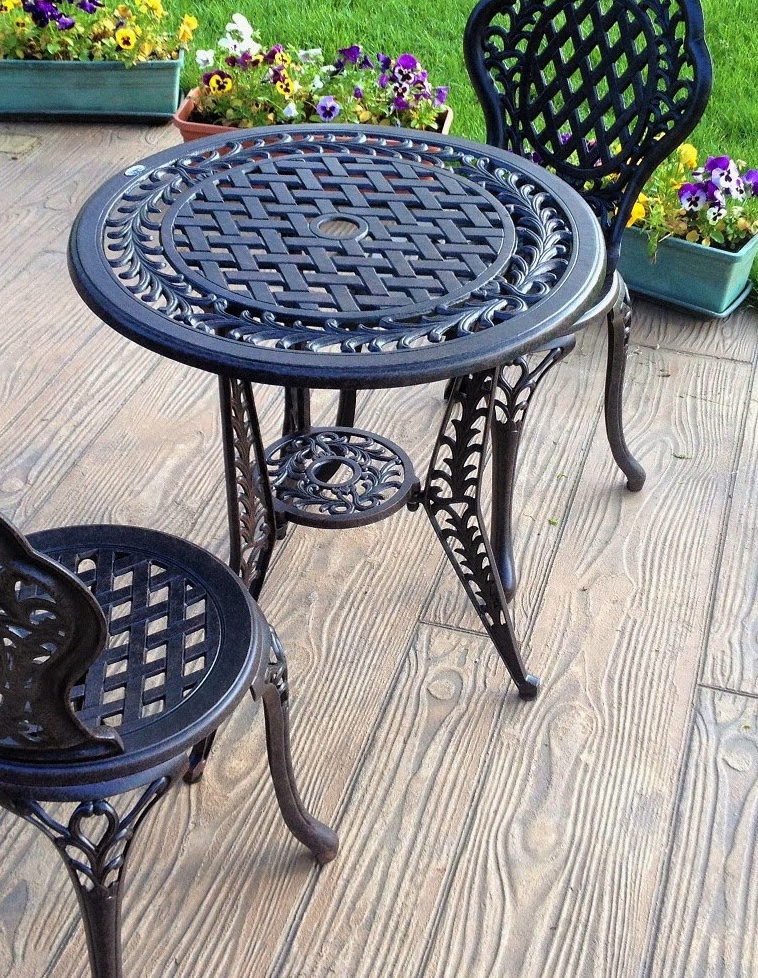
The durability means pavers are well-suited to supporting all types of outdoor patio furniture, however, over time, exposure to the great British weather can cause pavers to fade and in some cases even crack.
Regular cleaning and maintaining your concrete patio is advised to keep it protected but concrete can be stained if discoloured, and proper cleaning and sealing will help preserve its appearance and integrity for longer.
Concrete is a sturdy and reliable choice for patio surfaces, and it can accommodate a wide variety of outdoor furniture styles and materials.
Just ensure that you take care to protect both the furniture and the concrete surface, and your outdoor space should be both functional and stylish.
Pros: Durable, long-lasting, low maintenance, easy to clean, versatile design options, relatively cost-effective compared to natural materials, individual pavers can be replaced if damaged, good drainage so reduced risk of puddles.
Cons: Prone to cracking, can get hot in direct sunlight, does not always look as good as the real thing, weeds can grow between pavers if not properly maintained, pavers can shift or settle over time if not properly installed.
Best With: Wood, Rattan, Resin, Composite, Cast & Wrought Iron and Cast Aluminium Furniture.
3. Porcelain Tiles
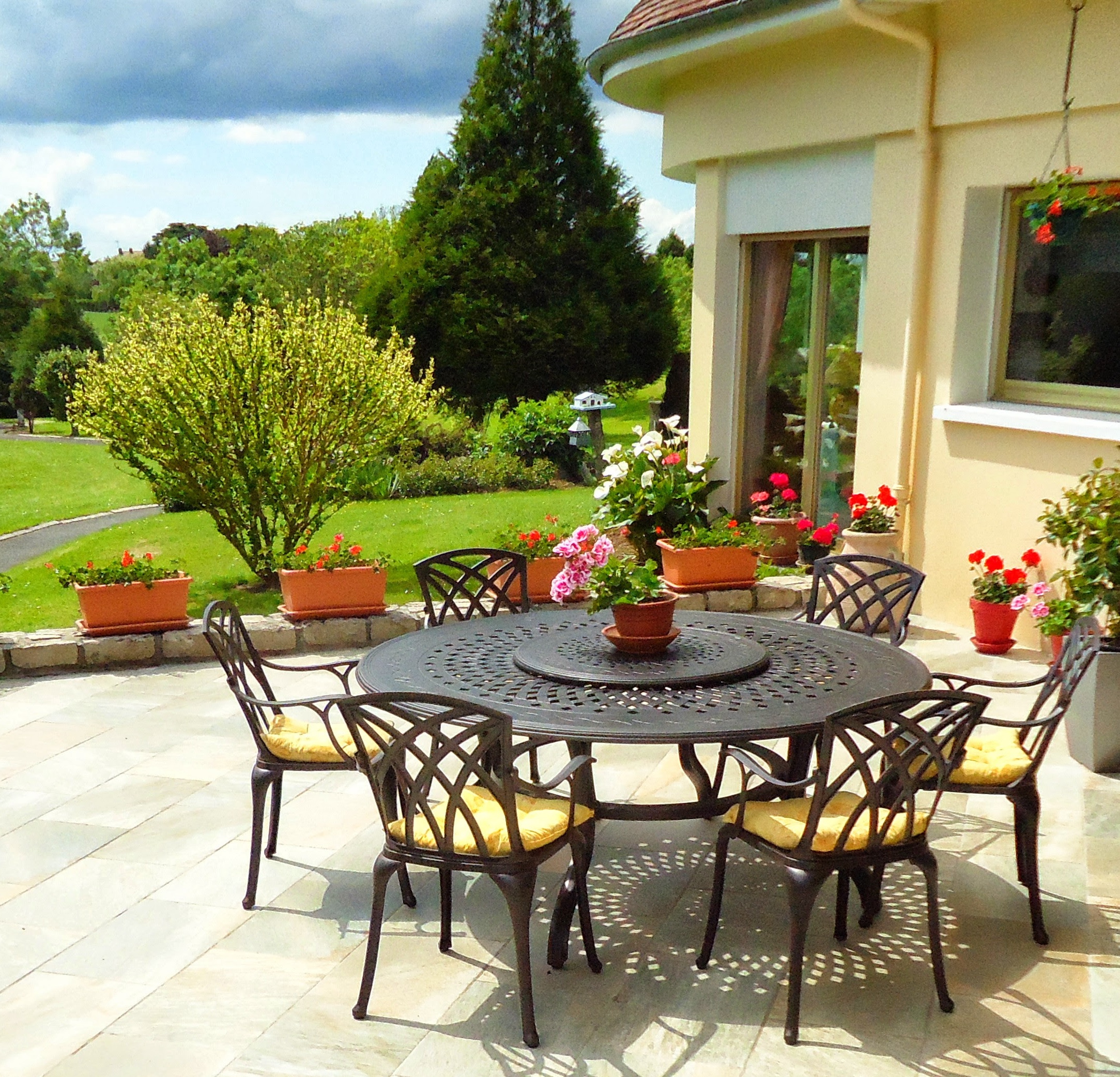
Porcelain tiles have become increasingly popular for patios in the UK due to their durability, low maintenance, and the wide range of stylish designs and colours on offer.
They are resistant to moisture, staining, and frost, which makes them a great choice for our climate, and whilst they are relatively low-maintenance, regular cleaning is advised to help keep them looking their best.
Not all porcelain tiles are created equal though, so be sure to select a product that is specifically designed for outdoor use.
You also need to be cautious with some cleaning products to ensure they are safe for use.
With the right care and precautions, you can safely and stylishly use all types of outdoor furniture on porcelain tiles. It, in our opinion, is the most durable material and it can withstand heavy-weight furniture, high, foot traffic, and the elements.
Pros: Wide range of colours, styles, and patterns available, easy to clean and maintain, resistant to moisture and staining, suitable for both indoor and outdoor use so can make the space feel as one for good design flow.
Cons: Some tiles can be slippery when wet, installation may be more complex and costly, tiles can crack or chip over time.
Best With: Wood, Rattan, Resin, Composite, Cast & Wrought Iron, Stainless Steel and Cast Aluminium Furniture.
4. Brick Patio
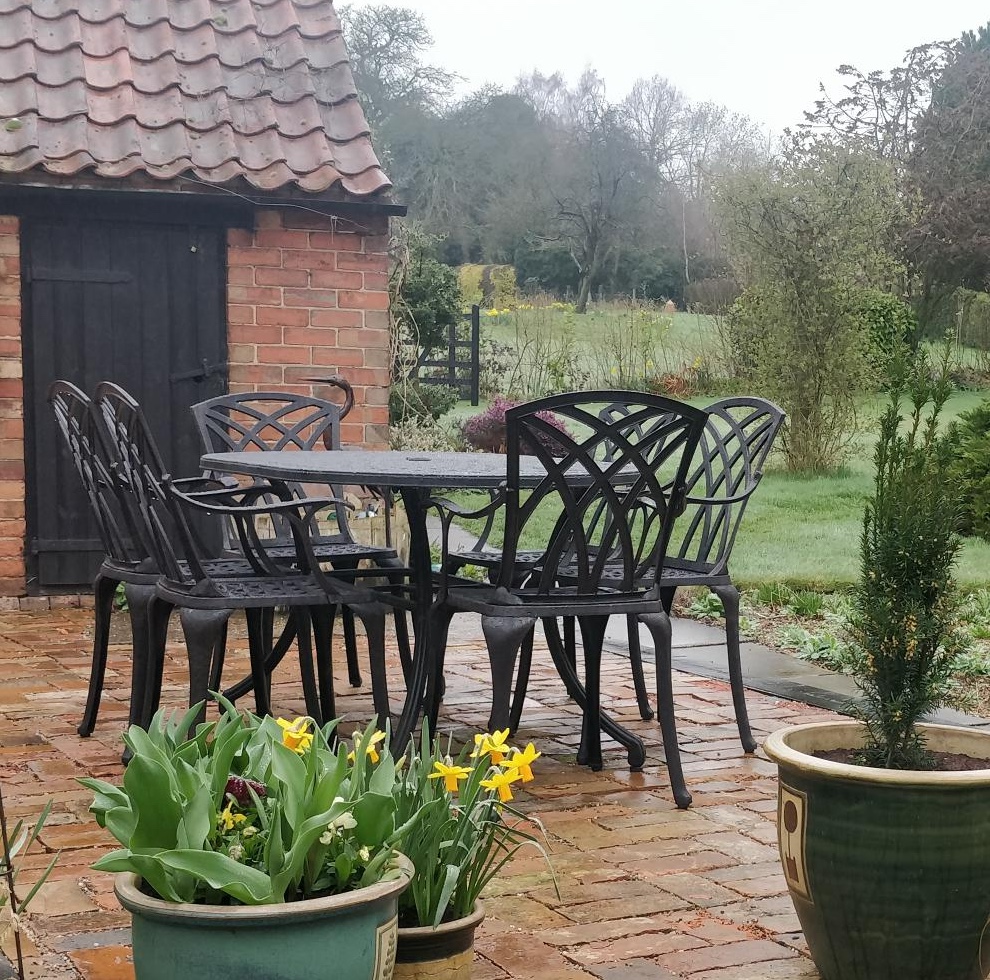
Traditional clay bricks are a classic choice of patio surface in the UK and they deliver a timeless and rustic appearance. Bricks are durable and will bring a charming, cottage-like feel to your outdoor space.
You do have to be a little more mindful of the weight of your furniture, especially if you have softer or older bricks that could be prone to crumbling.
Extremely heavy patio furniture can cause wear and tear on the bricks over time, so avoid concentrating pressure on specific areas of the brick, and arrange your furniture in a way that distributes the load evenly.
Using outdoor rugs or matting can help with weight distribution and protection on a brick patio. And whilst bricks are generally weather-resistant, prolonged exposure to the elements will affect their appearance.
Keep them clean and make sure any cleaning products are safe for use on bricks but, generally, they can accommodate a wide variety of furniture styles and materials, with a little care and precautions.
Pros: Timeless appearance, durable, can withstand the elements, doesn't require sealing, staining, or regular upkeep like wood or some stone surfaces, individual bricks can be replaced, bricks are porous allowing for good drainage.
Cons: Can be expensive, weeds can grow between joints if the patio isn't properly installed and maintained, over time bricks can shift causing the surface to become uneven, labour-intensive to install, can become hot in direct sunlight, colours can fade over time.
Best With: Wood, Rattan, Resin, Composite, Cast & Wrought Iron and Cast Aluminium Furniture.
5. Gravel
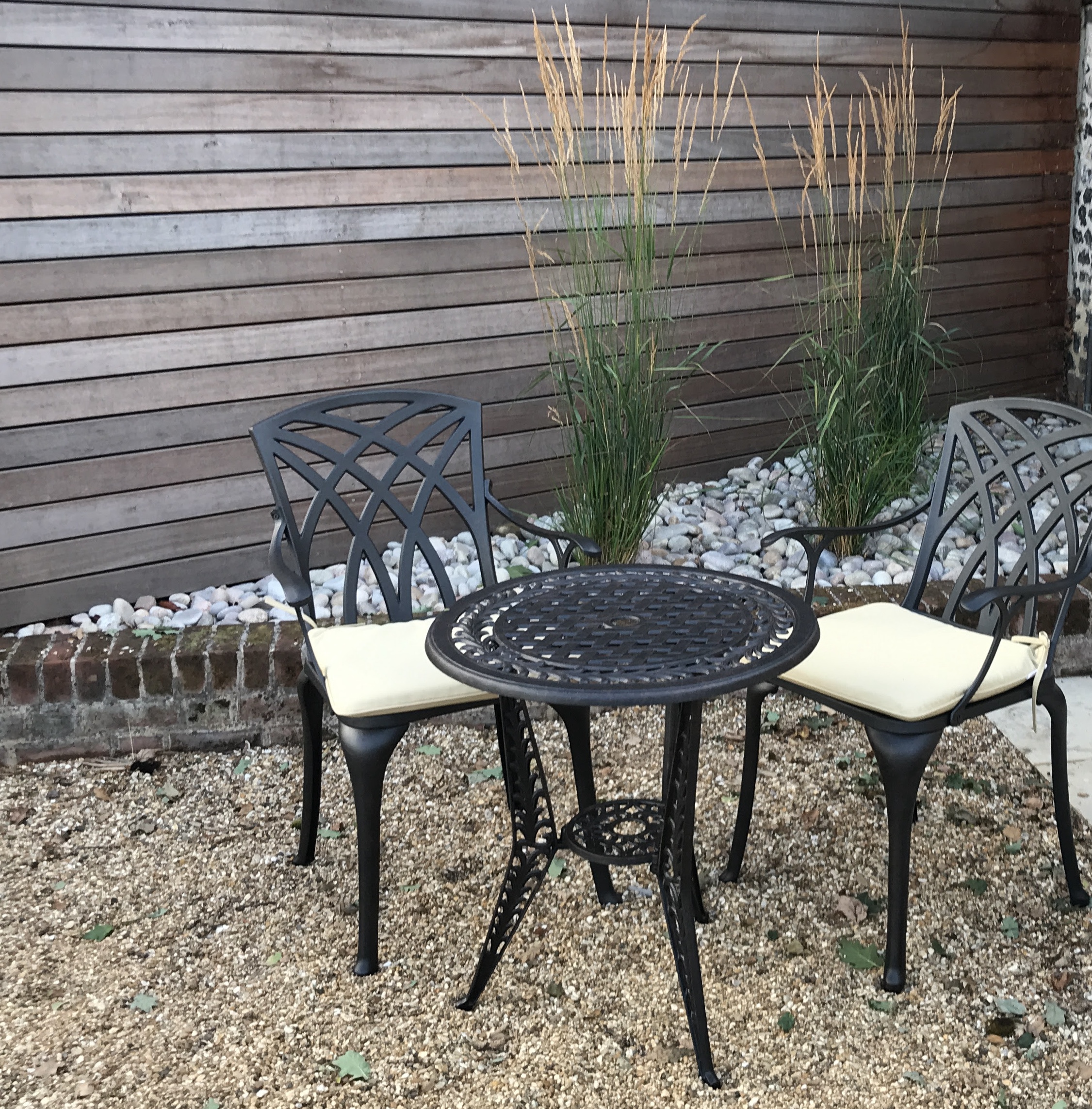
Gravel patios are a budget-friendly option that adds a rustic country-style look to your outdoor space. Gravel comes in various sizes and colours, and it provides good drainage, making it suitable for all the rain in the UK.
We looked at gravel in detail in our Can you put garden tables and chairs on gravel? post and whilst it is OK to put patio furniture on a gravel patio, we would advise caution.
Be aware of the weight of your furniture, especially if you have soft or loosely packed gravel as heavy furniture could sink into the gravel over time.
Organise your furniture in a way that minimises direct pressure on specific areas of the gravel or place pavers under the area where furniture legs will go to help with weight distribution, protection and stability.
Gravel patios require periodic maintenance to replenish and level the gravel. Weeds may also grow through the gravel, so routine weeding may be necessary.
While gravel patios have their unique charm and are relatively easy to install, they can present some challenges when it comes to stability and comfort for patio furniture.
With the right precautions and maintenance, you can enjoy your patio furniture on a gravel surface, but you need to make sure that it will not damage the feet on garden tables and chairs, etc as it can easily gouge timber, resin or rattan furniture or chip painted finishes on metal furniture.
Pros: Affordable and easy to install, allows for good drainage, creates a casual, rustic look, low maintenance and easy to replenish.
Cons: It can shift and become uneven, it is not comfortable for walking in bare feet, debris and weeds can accumulate over time, requires regular maintenance.
Best With: Rattan, Composite, Cast & Wrought Iron and Cast Aluminium Furniture.
6. Wooden Decking
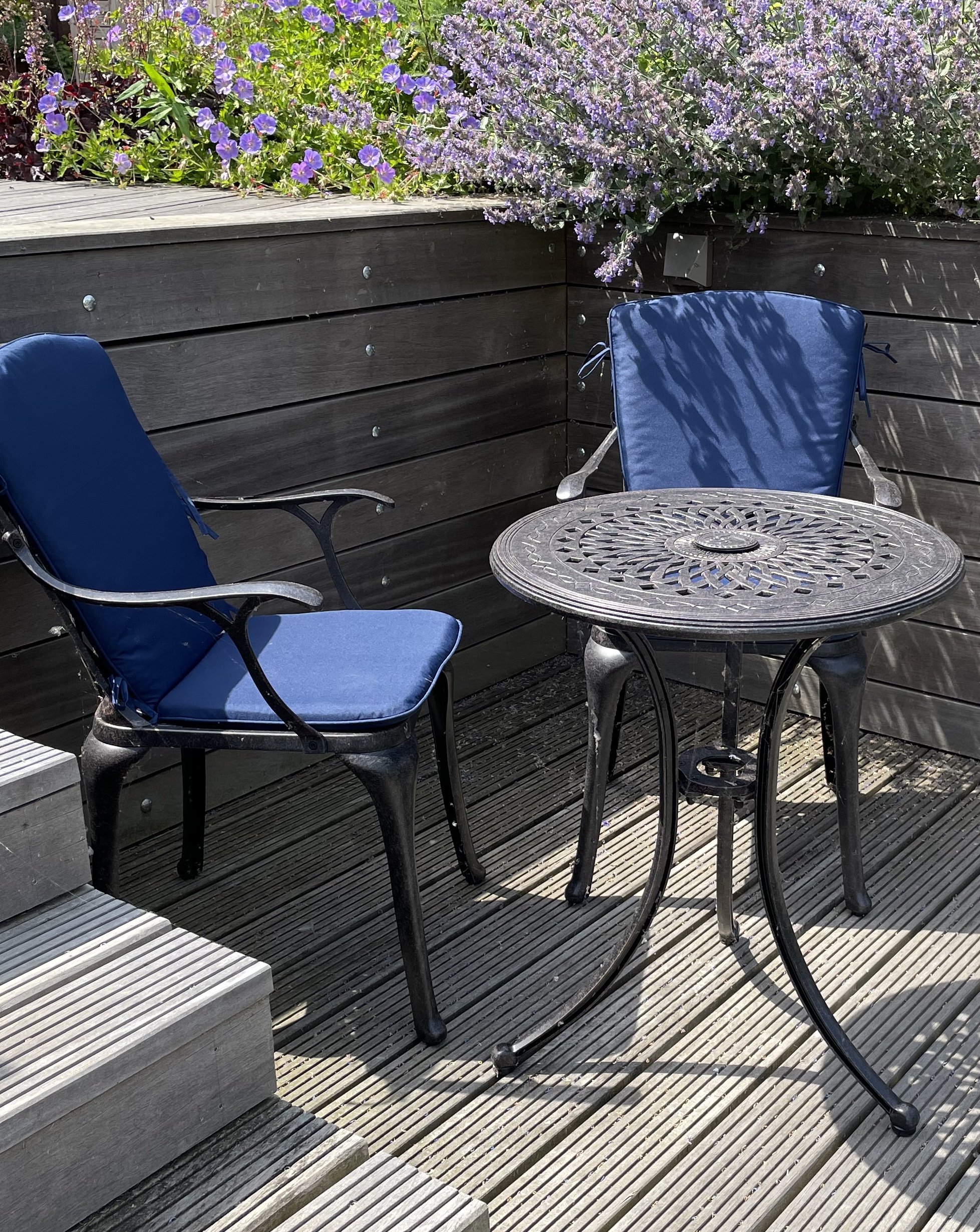
Wooden decking is a classic choice for patios, offering a natural and warm appearance, and its suitability was discussed in our Will our metal garden furniture damage wood and composite decking? article.
We love a deck here at Lazy Susan but there’s no escaping you have to be ready for regular maintenance, such as staining or oiling, in order to protect the wood from the UK's damp conditions.
Wood is also easily scratched, scored and gouged, so you have to be careful with the type of patio furniture you put on it and try and stay away from anything too heavyweight.
However, decks are a visually appealing choice for outdoor surfaces, and they can still accommodate a wide variety of outdoor furniture styles and materials.
The right care and precautions are necessary but you can safely and stylishly use patio furniture on a wood deck.
Pros: Offers a natural appearance, is suitable for elevated or sloped landscapes, can be treated to resist decay and insects, easy to install and modify.
Cons: Regular maintenance is required, including staining and sealing, susceptible to rot, decay, and splintering, initial installation cost can be high, depending on the type of wood used.
Best With: Wood, Resin, Rattan, Composite and Cast Aluminium Furniture.
6. Composite Decking
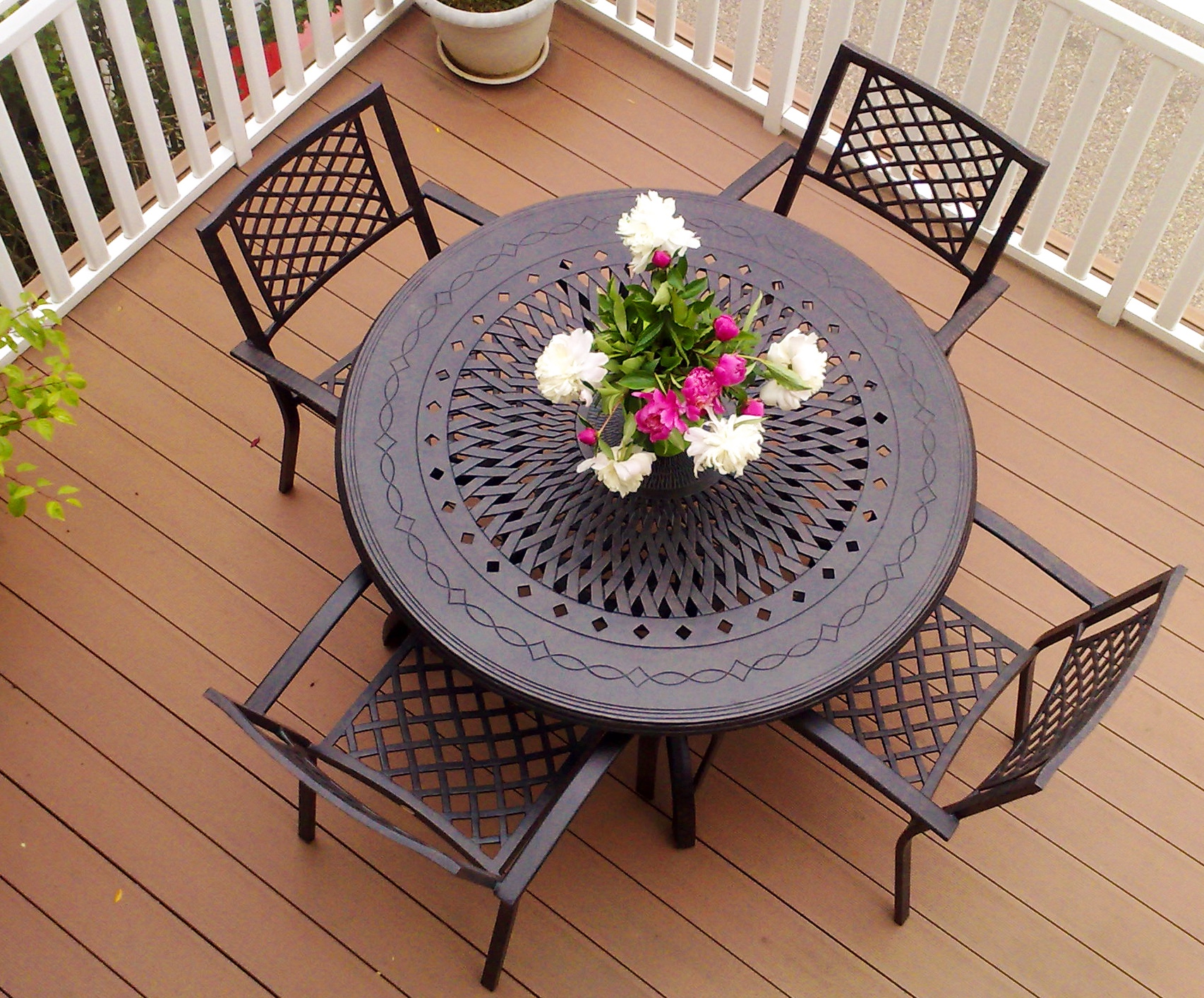
Composite decking is the new kid on the block and they are made from a number of different materials such as compressed wood fibres and recycled plastics.
Much like pavers do for natural stone, they create the look of a timber deck in a lower maintenance and better weather-resistant package that is less susceptible to rot, mould, and pests.
The reduced maintenance in particular has driven the popularity and it is much better suited to supporting patio furniture than its natural sibling.
That said, you still need to exercise a little caution when using patio furniture on a composite deck, and prolonged exposure to the British weather will affect their appearance and they can fade when exposed to the sun.
Composite decks are a durable and attractive choice for outdoor surfaces and can accommodate a wide variety of outdoor furniture styles and materials.
Pros: It doesn't need staining, sealing, or regular painting like wood, highly resistant to rot, decay, insects, and warping, wide range of colours and finishes, made from recycled materials and is considered more environmentally friendly than traditional lumber, splinter-free and slip-resistant, designed to resist fading from UV exposure.
Cons: Can be more expensive upfront compared to wood, some composite decks can become hot in direct sunlight, composite boards may have more flex or give than traditional wood boards, can still be scratched or scuffed, difficult to repair.
Best With: Resin, Rattan, Composite and Cast Aluminium Furniture.
8. Cobblestones
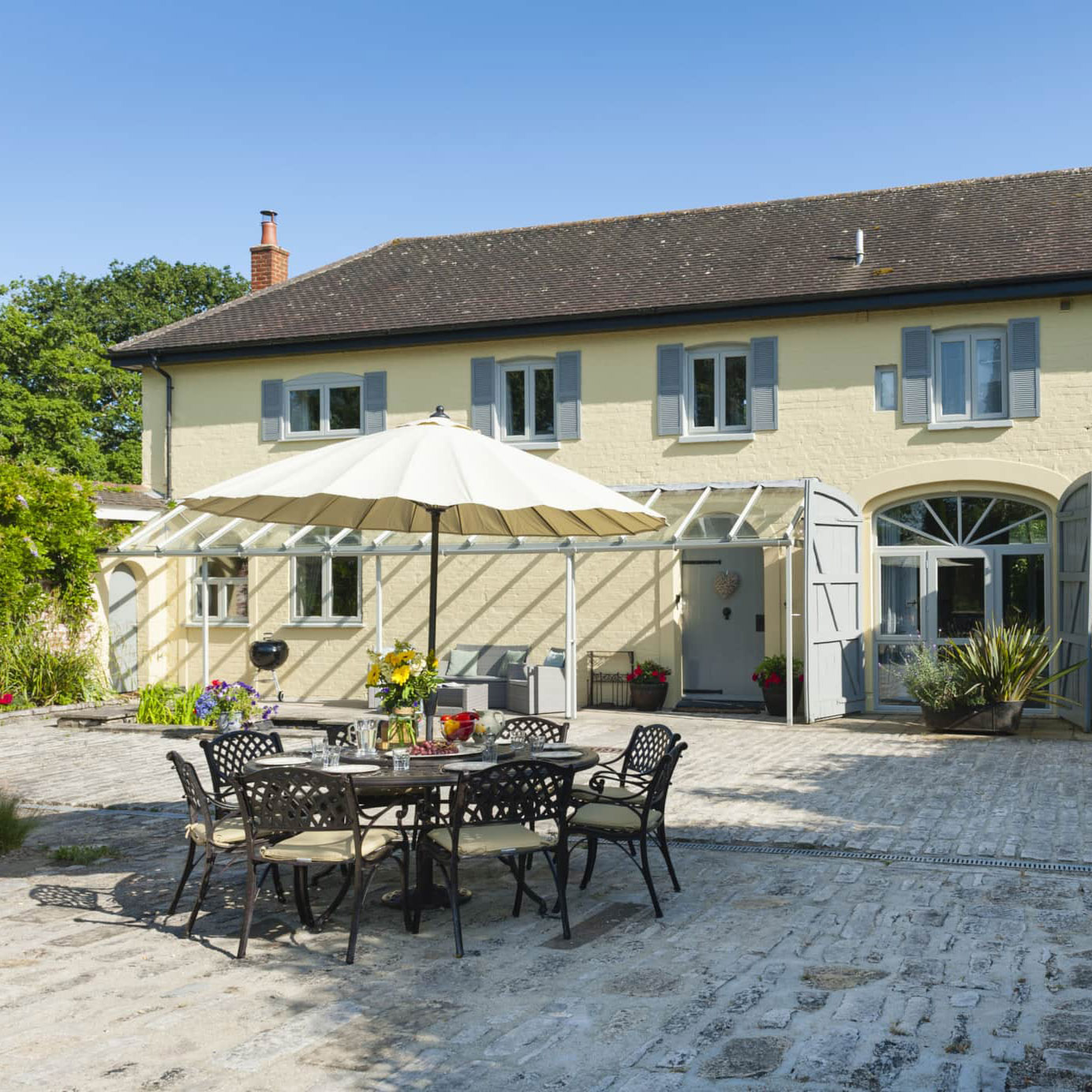
Cobblestones or setts bring a charming look to patios that is a popular choice of material for those with a traditional farmhouse or cottage garden.
They are prone to movement over time so they will need maintaining, such as re-levelling or re-grouting if the stones settle or shift over time
You can also minimise movement by avoiding putting pressure on specific cobblestones for too long and distributing the load evenly, and whilst they are durable and can stand up to the UK weather, the cobbles can get a little slick when wet.
Cobbles are a classic and robust choice for outdoor surfaces, and they will give your patio a unique and charming ambience, plus, with the right care and precautions, you can safely place the patio furniture on a cobblestone patio.
Pros: Timeless and rustic look that can enhance the visual appeal of your outdoor space, incredibly durable and can withstand heavy foot traffic and vehicular use, requires minimal maintenance if properly installed, natural drainage reduces the risk of standing water,
Cons: More expensive to install than some other paving materials, cobblestone surfaces can be uneven, weeds can grow between the gaps, installation is labour-intensive, over time they can develop a weathered or discoloured appearance.
Best With: Wood, Cast & Wrought Iron, Stainless Steel, Cast Aluminium Furniture.
9. Artificial Grass
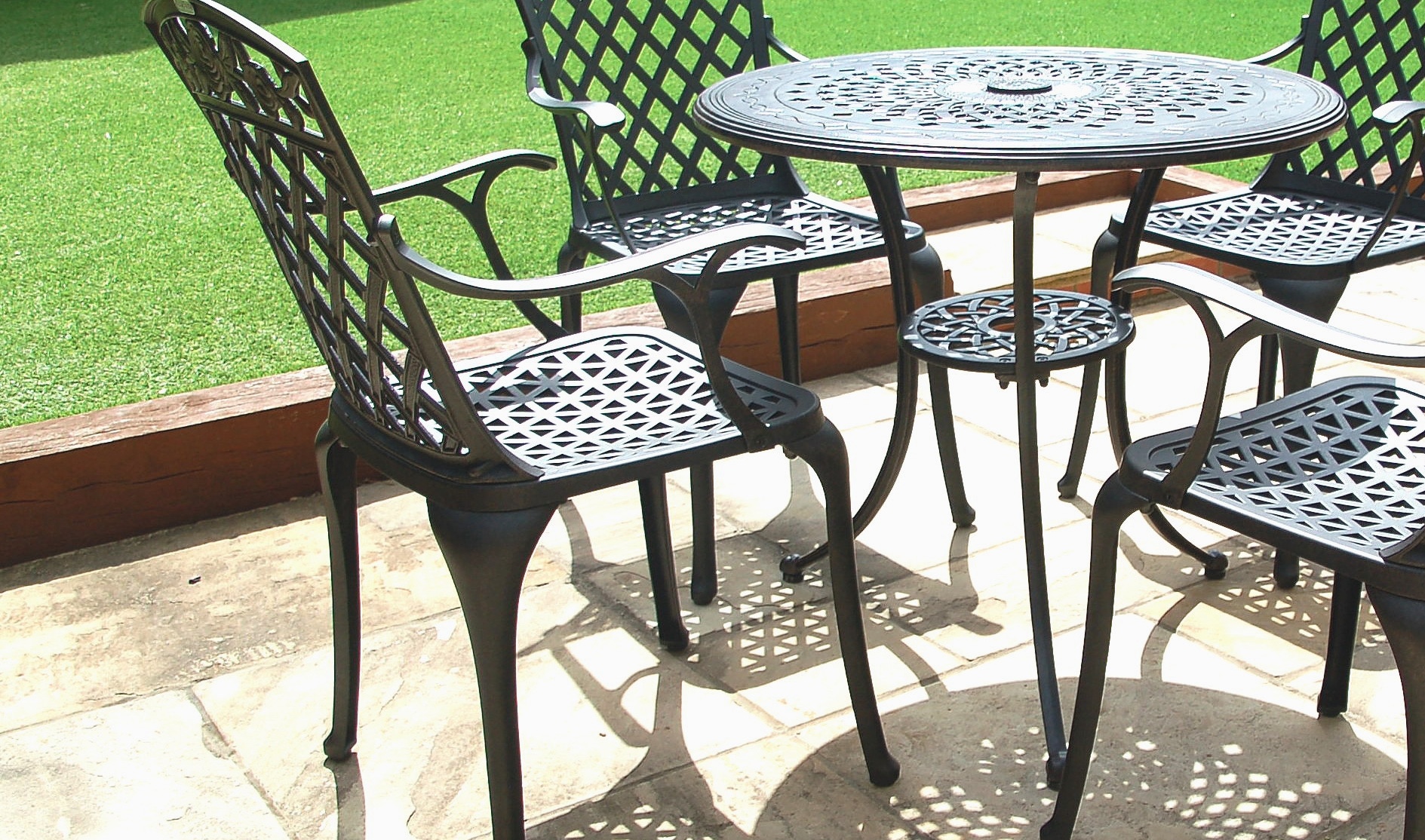
Many homeowners in the UK are choosing artificial grass as a patio surface as it creates a low-maintenance, green space. This option provides a lush appearance throughout the year without the effort required for the real thing.
Artificial grass, also known as synthetic turf, is designed to be a durable and practical surface but much like a carpet inside the home, it is prone to indentations from patio furniture if it is left in the same spot too long.
We looked in detail at this in our Can you put metal garden furniture on artificial grass? post, and we stressed that you have to be mindful of the weight of your furniture, especially if you have a softer or older artificial turf. Moving heavy furniture can cause more wear and tear on it over time.
To avoid concentrating pressure on specific areas of the artificial grass, arrange your furniture in a way that distributes the load evenly. Placing outdoor rugs or mats under the furniture can help with weight distribution and protect the surface.
Artificial grass is generally weather-resistant and can handle exposure to the elements, but it can become hot to the touch during sunny weather. It is low-maintenance though, but regular cleaning will help keep it looking its best, so remove leaves, debris, and any stains quickly to maintain its lush colour.
Artificial grass is a convenient and visually appealing choice for outdoor surfaces, and it can accommodate a variety of outdoor furniture styles and materials. With the right care and precautions, you can safely put most types of patio furniture on it.
Pros: You don't need to mow, water, or fertilize, helps to conserve water, offers year-round greenery, no allergy or pest issues, designed to withstand heavy foot traffic, provides a consistent and even surface.
Cons: Initial installation of artificial grass can be expensive, can get hot in direct sunlight, it can fade or discolour due to exposure to UV rays, while modern artificial grass has improved in terms of realism it will not replicate the look and feel of the real thing, rainwater doesn't naturally penetrate artificial grass.
Best With: Rattan, Resin, Composite and Cast Aluminium Furniture.
10. Resin-Bound Gravel
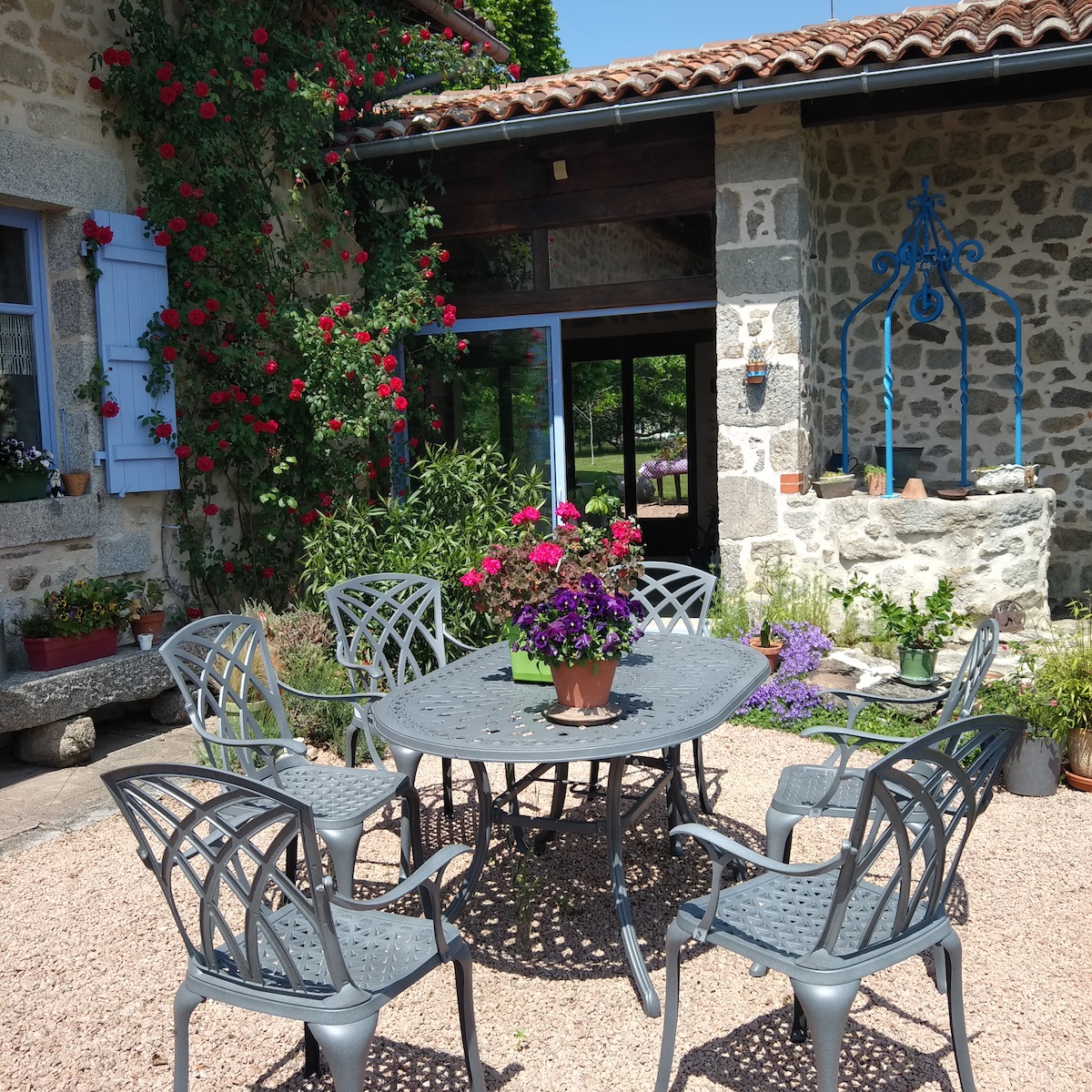
Resin-bound gravel combines natural gravel with a clear resin binder to create a smooth, solid surface. It offers good drainage and can be customised in various colours and patterns.
Whilst not new as such, it has been used on driveways for a while now, it is becoming a more popular choice for patio surfaces as it combines the natural appearance of gravel with greater durability.
You do need to be mindful of the weight of your furniture though, especially if you have a softer or less stable resin surface. Heavy furniture may cause more wear and tear over time and it can be tricky to repair.
Again, as with many of the softer patio surfaces, we would avoid concentrating pressure on specific areas of the resin-bound gravel, and arrange your furniture in a way that distributes the load evenly.
It is generally weather-resistant, however, prolonged exposure to the elements can affect its appearance. They are also relatively low-maintenance but regular cleaning and maintenance is necessary.
Resin-bound gravel offers an attractive and stable surface for most types of garden furniture, combining the natural look of gravel with the convenience of a bound surface.
Pros: Resistant to weeds, durable, provides a smooth and stable surface, UV-stable and does not fade significantly under sun exposure, relatively quick to install.
Cons: More expensive to install than traditional loose gravel, professional installation is critical, not ideal for heavy items, difficult to repair, can be slippery when wet, resin can develop hairline cracks in time.
Best With: Rattan, Resin, Composite and Cast Aluminium Furniture.
As we stated earlier, the choice of patio surface material depends on factors like your budget, maintenance preferences, desired look, and the specific climate in your location.
The furniture we have suggested pairs best with each material is simply our opinion and based on our experiences.
If you’re unsure of which will work best, then our advice would be to speak with a landscaping professional or supplier to determine the best solution for your specific needs and garden.
How to protect your patio furniture and surface
With many of the materials above, we mentioned that they will work with most types of patio furniture with a little care and precaution, and that is what we want to look at now.
Even with the hardiest of materials, it is worth looking at ways to protect, and we have some excellent tips to keep both patio and furniture in tip-top condition regardless of what you have or want:
1. Keep the patio furniture level
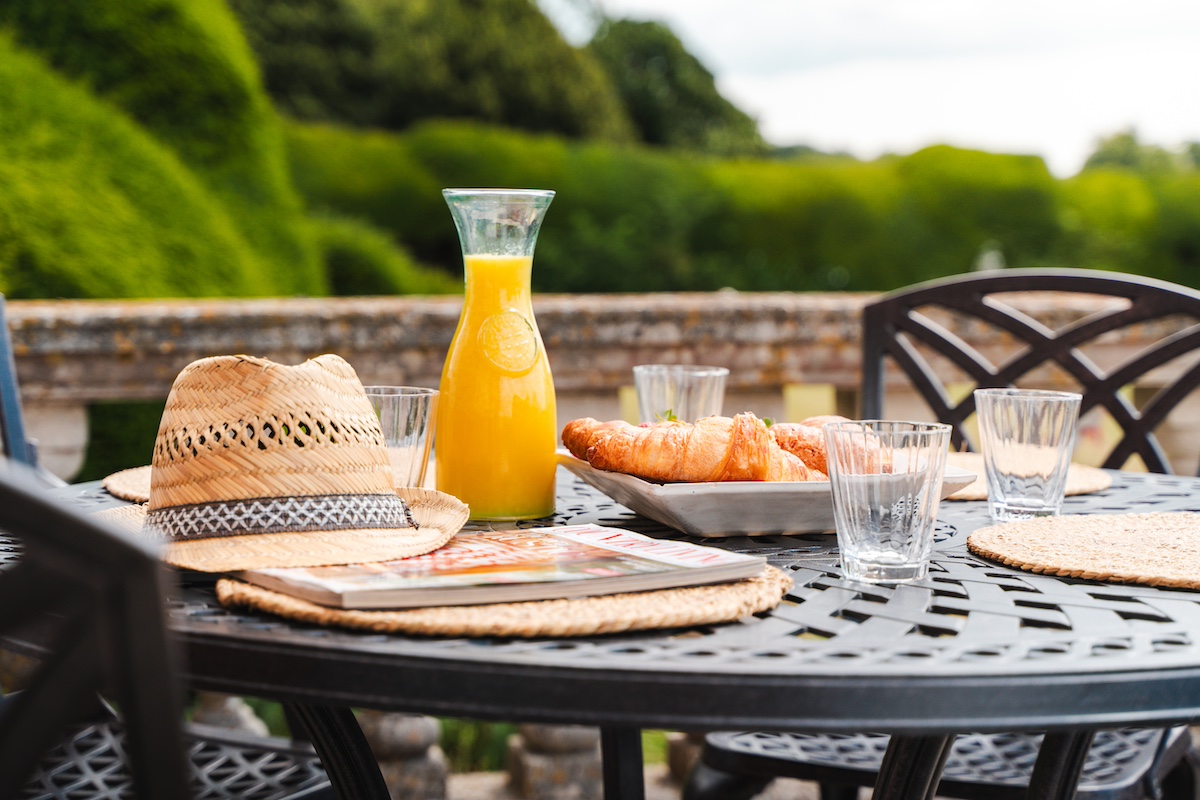
In all cases, regardless of surface or furniture material, it is essential that you make sure that the furniture you choose is stable and well-balanced to prevent it from tipping over or wobbling, especially on uneven surfaces.
If you’re installing new then ensure that the patio surface is level and free of any major irregularities or uneven areas. An uneven surface can make your furniture unstable or uncomfortable to use.
With some materials such as natural stone or gravel, this can be tricky, which is why we supply all our patio tables and chairs with screw-in plastic feet (shown in the photo below).
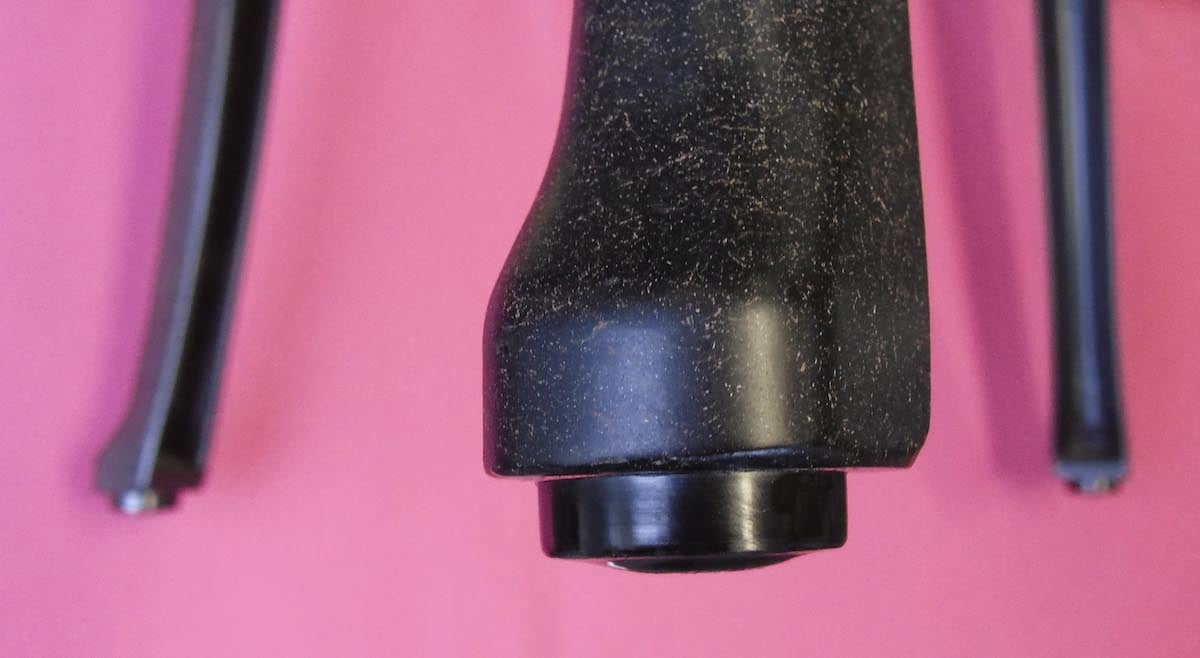
This provides two benefits. First, there is a little bit of adjustment for uneven patio surfaces. Second, it also helps protect the painted finish on your Lazy Susan furniture from chips when moving it about on a rough surface.
2. Add extra protection to the feet
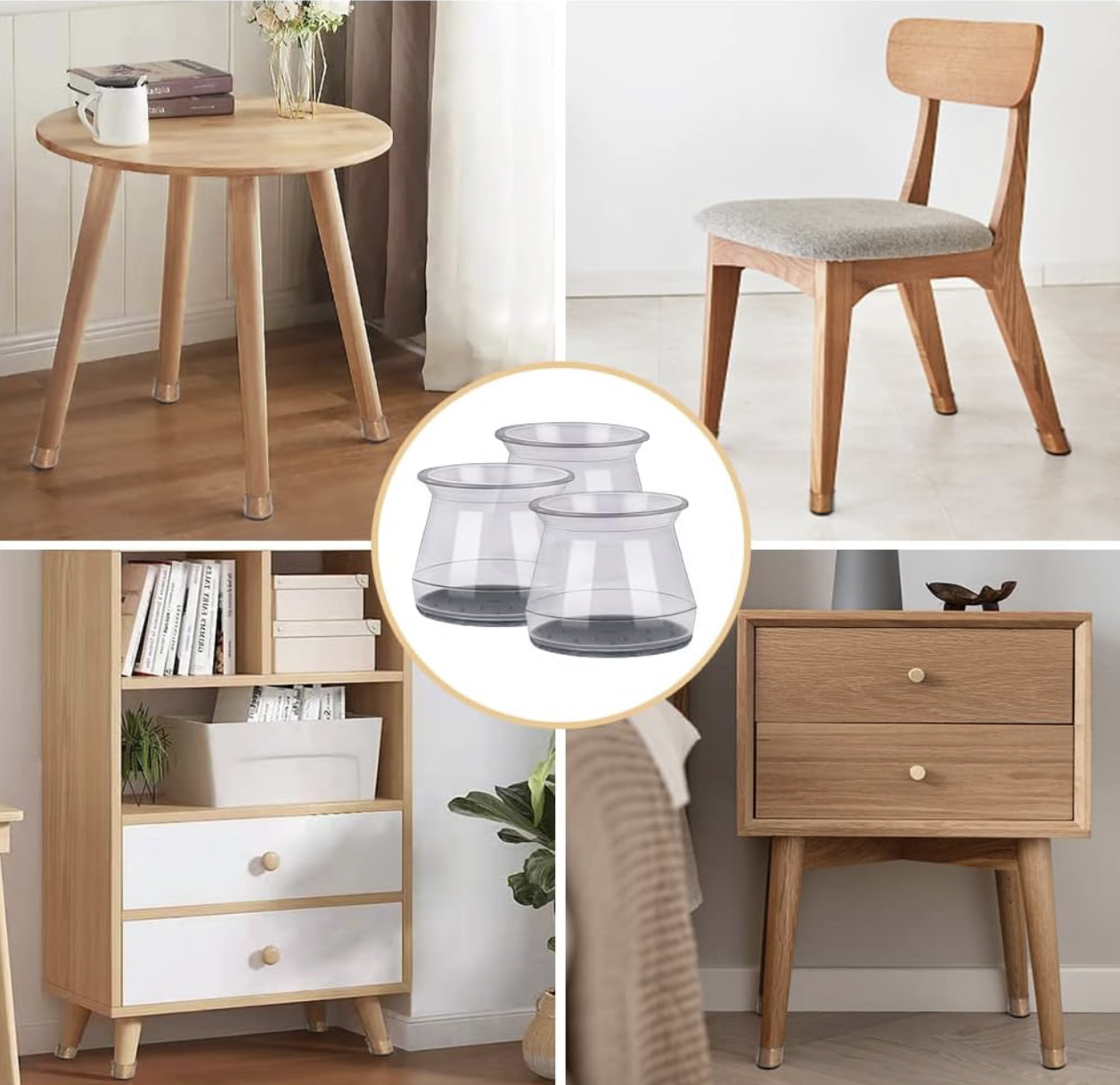
It is also a good idea to use furniture pads or gliders under the legs of your furniture to protect both the patio surface and the furniture itself from any marks, chips or scratches.
There is a variety of different options available such as furniture pads, bases, or rubber feet such as those from Cosing (above on Amazon) that you can place under the legs of chairs and tables for a little peace of mind. Just shop around for the type/shape that will fit best.
Protecting your patio furniture on a rough surface such as concrete, natural stone, cobblestones, brick, etc is important to ensure it not only stays looking good but also remains weatherproof.
With wooden patio furniture, it could lead to the wood warping or even rot. With metal furniture such as our range, if the painted finish is compromised it can lead to problems.
3. Use outdoor rugs
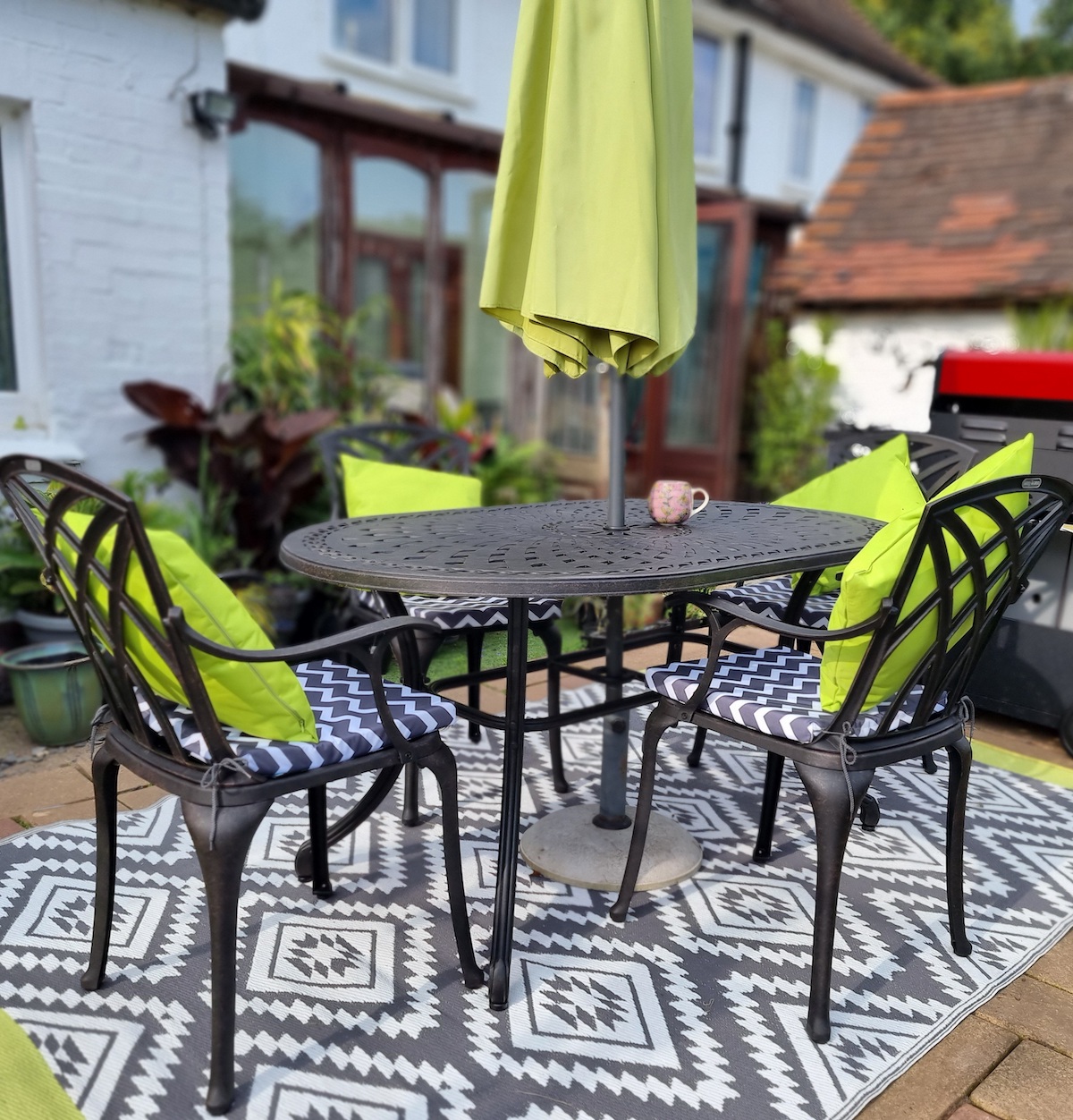
Here at Lazy Susan, we are big advocates of the outdoor rug, as a design statement, for providing comfort and adding extra protection.
They look great but they also act as a protective layer for both the patio surface and the furniture. They can prevent direct contact between the legs and any rough surfaces to reduce wear and tear.
4. Regularly clean your patio
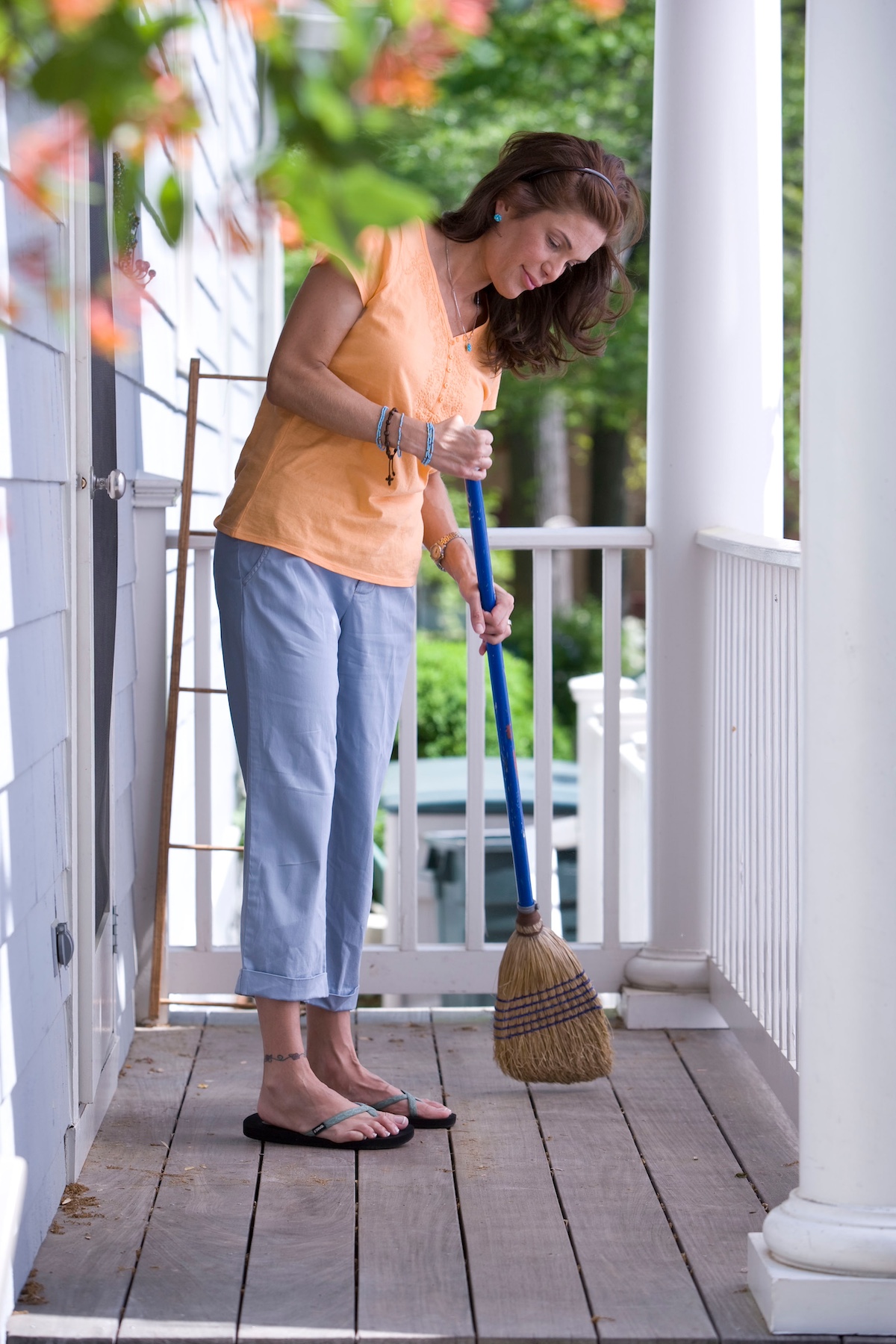
Regularly cleaning your patio furniture and the patio surface is a simple but effective way to protect both and prevent damage.
Dust, dirt, and debris can accumulate under furniture legs and cause abrasions over time.
Cleaning will also prevent any staining from spills, tree sap or bird droppings, for example.
5. Apply protection to your patio surface
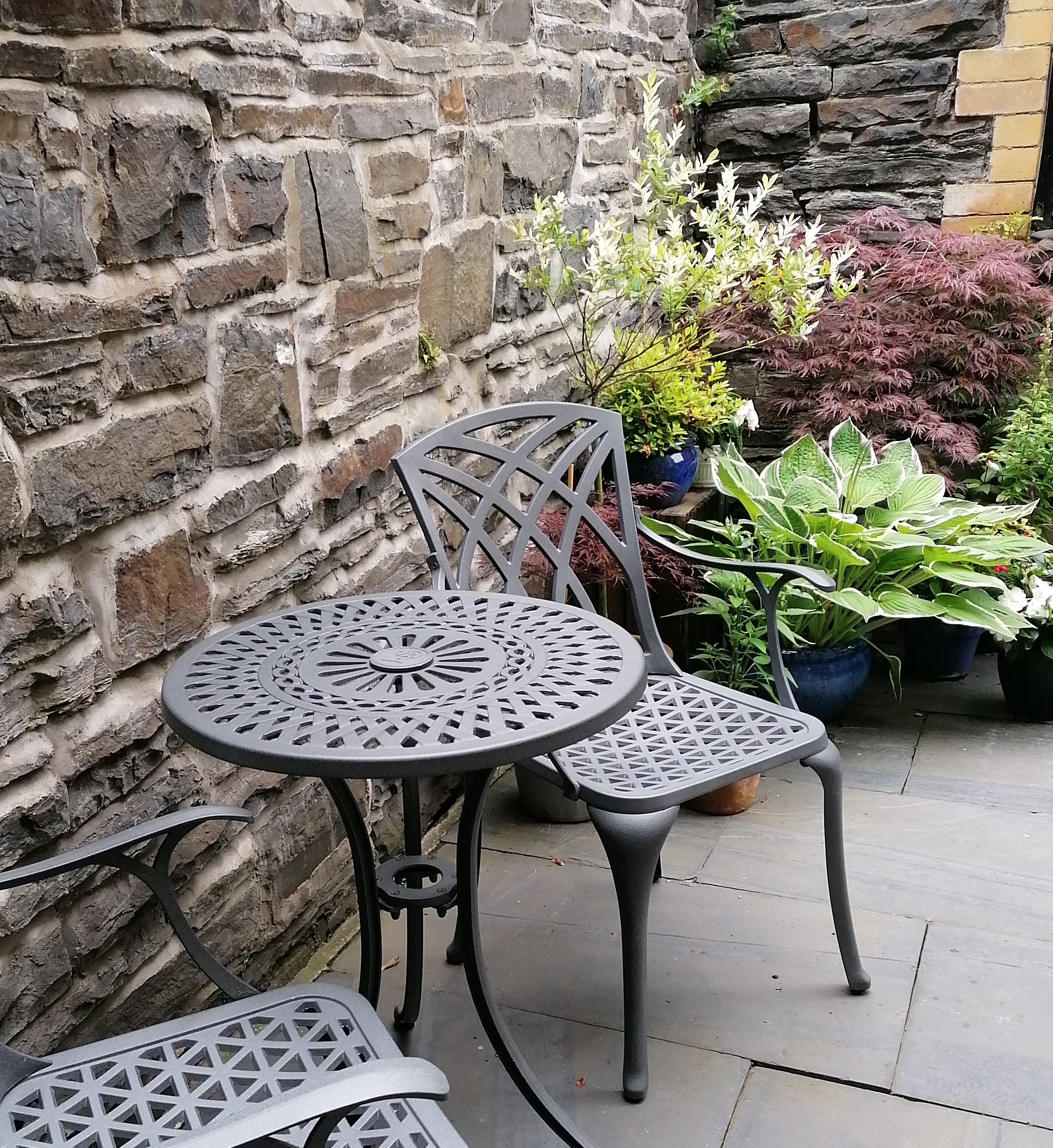
If your patio isn't already sealed, then you should definitely consider applying some form of protection.
For all of the materials listed above there will be specialist cleaning solutions and sealants to provide protection from the elements and general wear and tear.
Do a little research and shop around for the right solutions.
We would always recommend you test first on a part that’s not visible and look for products that will not only protect from moisture and stains but also make it easier to clean.
6. Use patio furniture covers
To protect your furniture, we would always advise that you invest in some fitted covers to protect it from the elements and keep it clean and ready to use.
Individual covers with tie fastening for each item are better than the large cover-alls, and they’ll shield your furniture from the rain, sun, and dirt.
Covers & All has a comprehensive range on Amazon that is made from a breathable 12 Oz fabric that is both water and UV-resistant (their chair cover is pictured above).
7. Move furniture off your patio in bad weather
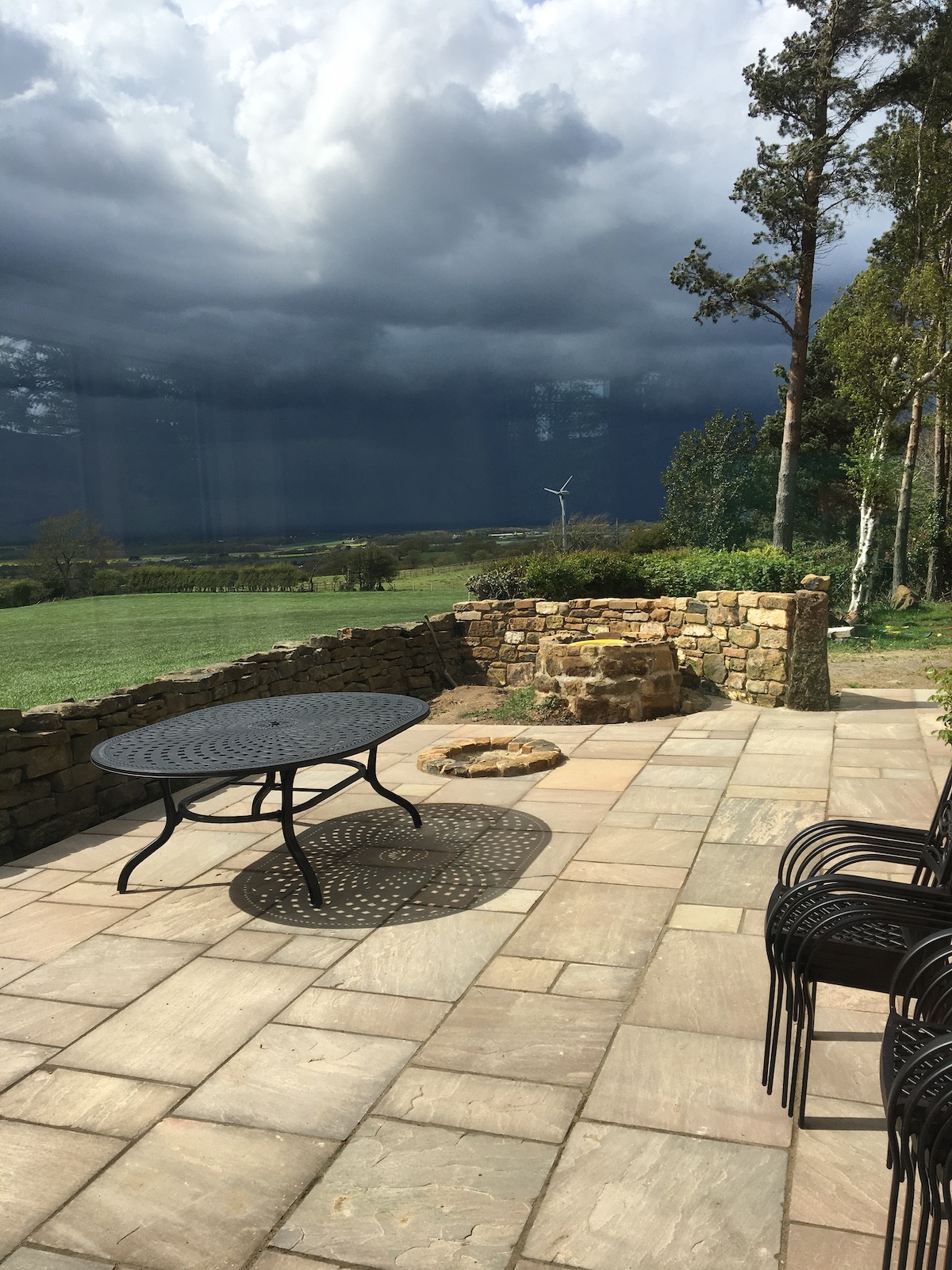
If you don’t have a place to store your patio furniture in bad weather, then along with some good covers, move it to a safe part of the patio.
Our cast aluminium is weatherproof and whilst it is happy sitting in heavy rain and snow, the wind is a different matter. Any forecasts above the 35 mph mark and we would advise you move it into a safe more sheltered spot such as a corner or against a wall.
We have seen many a scratched garden chair and chipped patio surface from strong winds in our time than probably any other form of weather damage.
8. Move your patio furniture
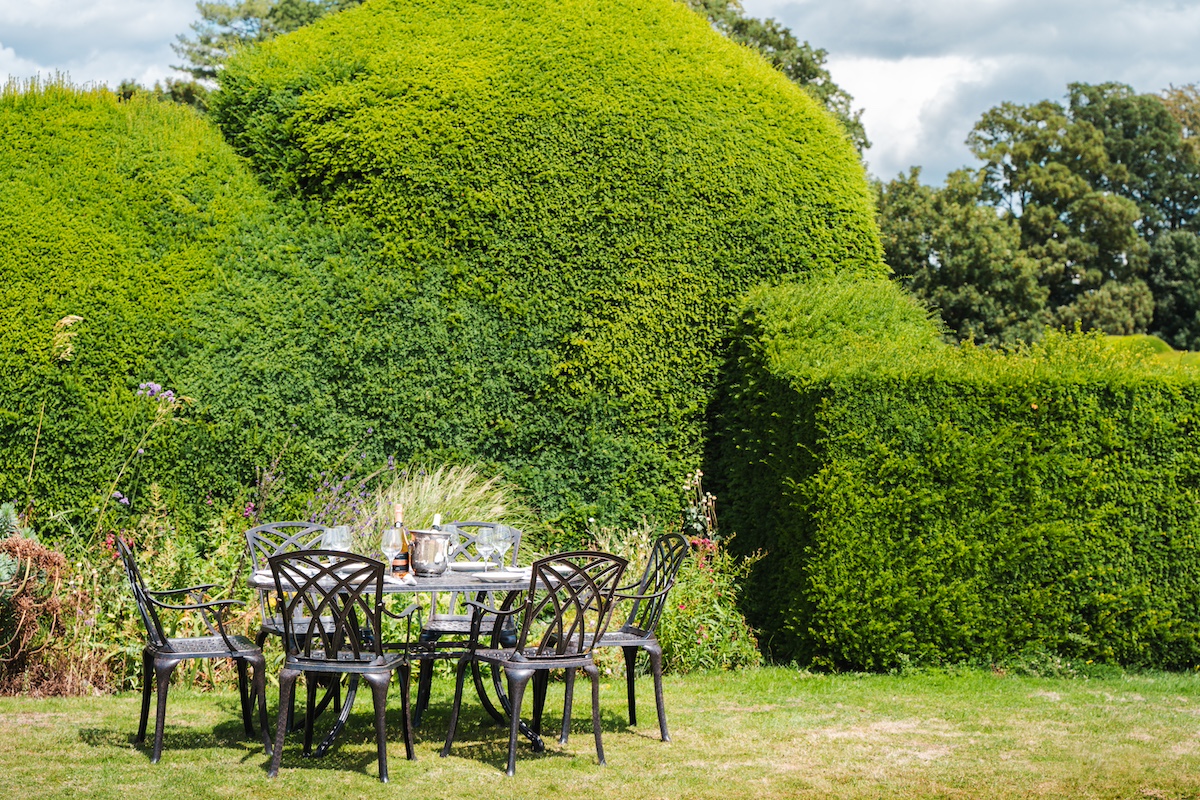
With many of the materials we also mentioned the need to avoid concentrating pressure on the same area for too long and distributing the load evenly.
This is because much like a carpet inside the home, heavy furniture on softer materials such as resin-bound gravel, wood decking, composite decking and real or artificial grass can leave indentations.
By occasionally moving your furniture you can prevent the formation of permanent indentations on the surface. This is especially important for heavy items like large outdoor dining tables and sofa-style sets.
This can in rare cases also happen with the more durable materials like concrete and natural stone, so it pays to be vigilant with all different types.
You don’t need to move it much, just a little shuffle to place the legs in a different spot once or twice a year will suffice when cleaning.
9. Do not drag your garden furniture
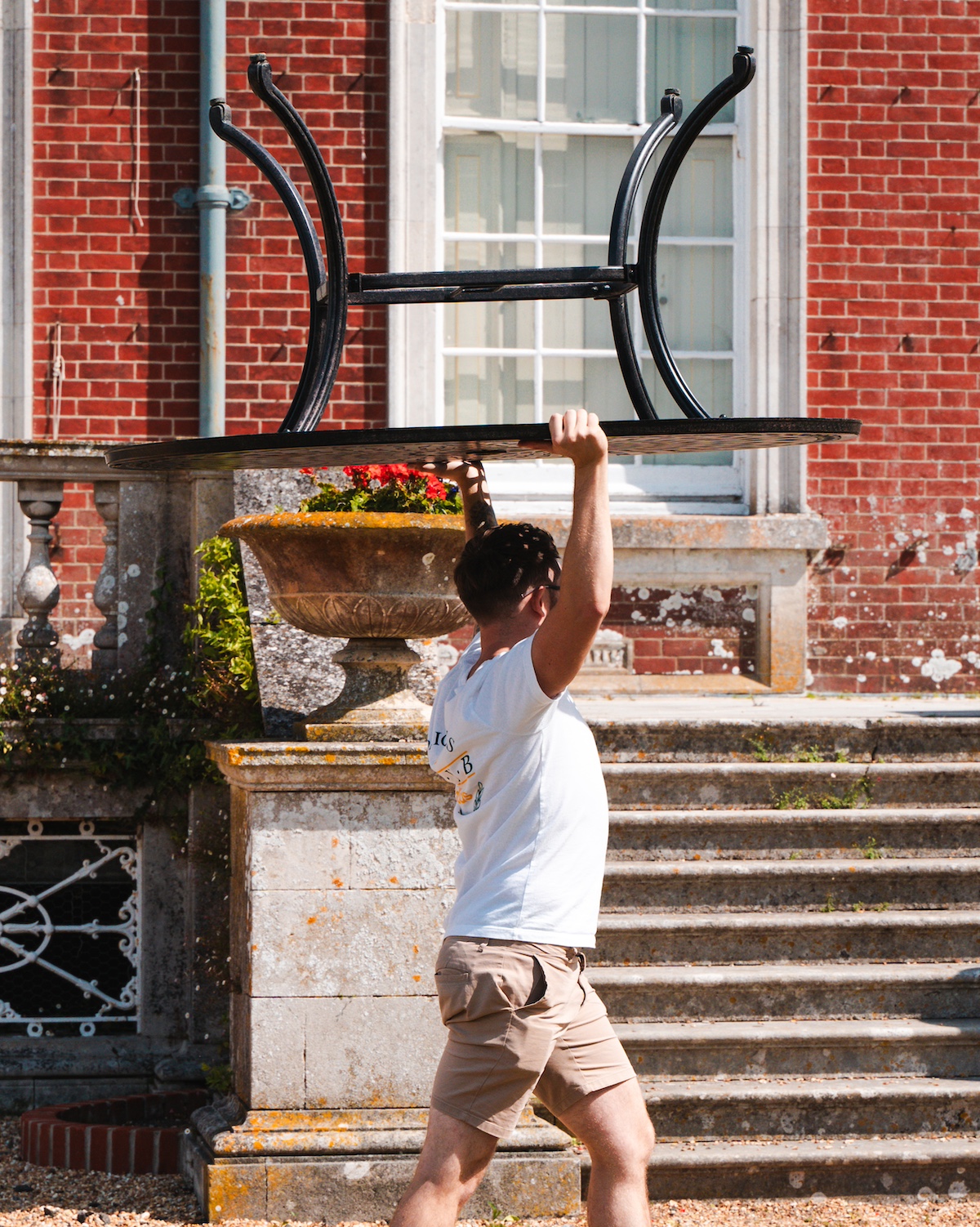
Again, regardless of surface or furniture material, we also always recommend you lift and carry your furniture rather than dragging it across your patio.
Dragging can cause both surface damage and may also damage the furniture itself.
Our furniture is supplied with the aforementioned screw-in feet and they should prevent this from happening but it still pays to be careful.
10. Regularly inspect and maintain your outdoor furniture
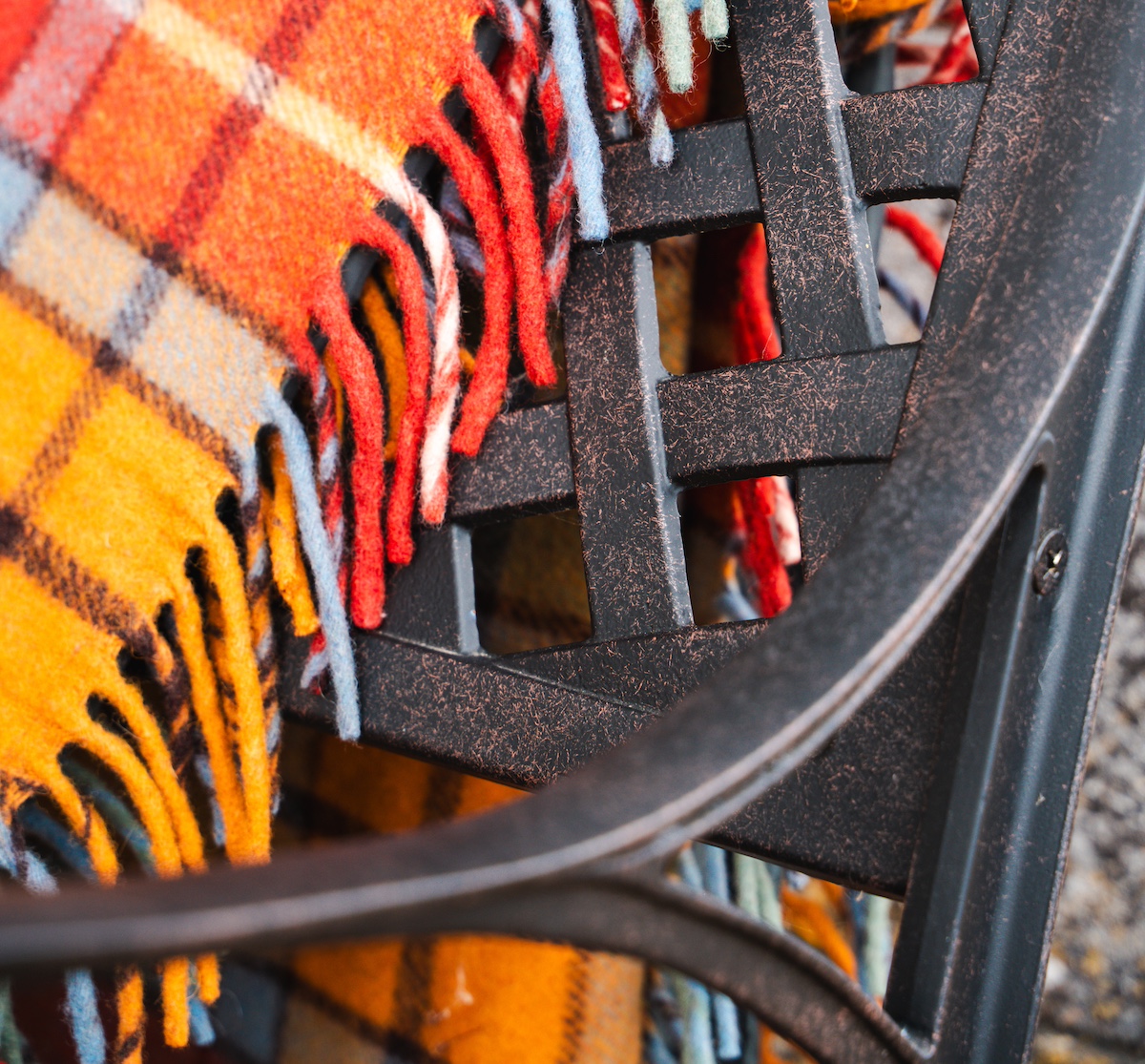
Regularly inspecting both your furniture and patio surface for signs of wear, rust, damage, etc. is also critical.
Please address any issues promptly to prevent them from getting worse. If it isn’t a problem you can fix it yourself, then speak to a professional.
If you find any chips or scratches in your furniture, then they are easy to repair with our Touch Up Kits and the video below takes you through the application process:
By following the steps above, you can keep your patio surface and furniture in good condition and prevent any unsightly damage. Proper maintenance and protective measures should help to prolong the life of both.
If you have any photos of your Lazy Susan Patio Furniture, we’d love to see a few for our Do Some Good charity campaign. You can tag us @LazySusanFurniture on Instagram or Facebook or Upload Here.




